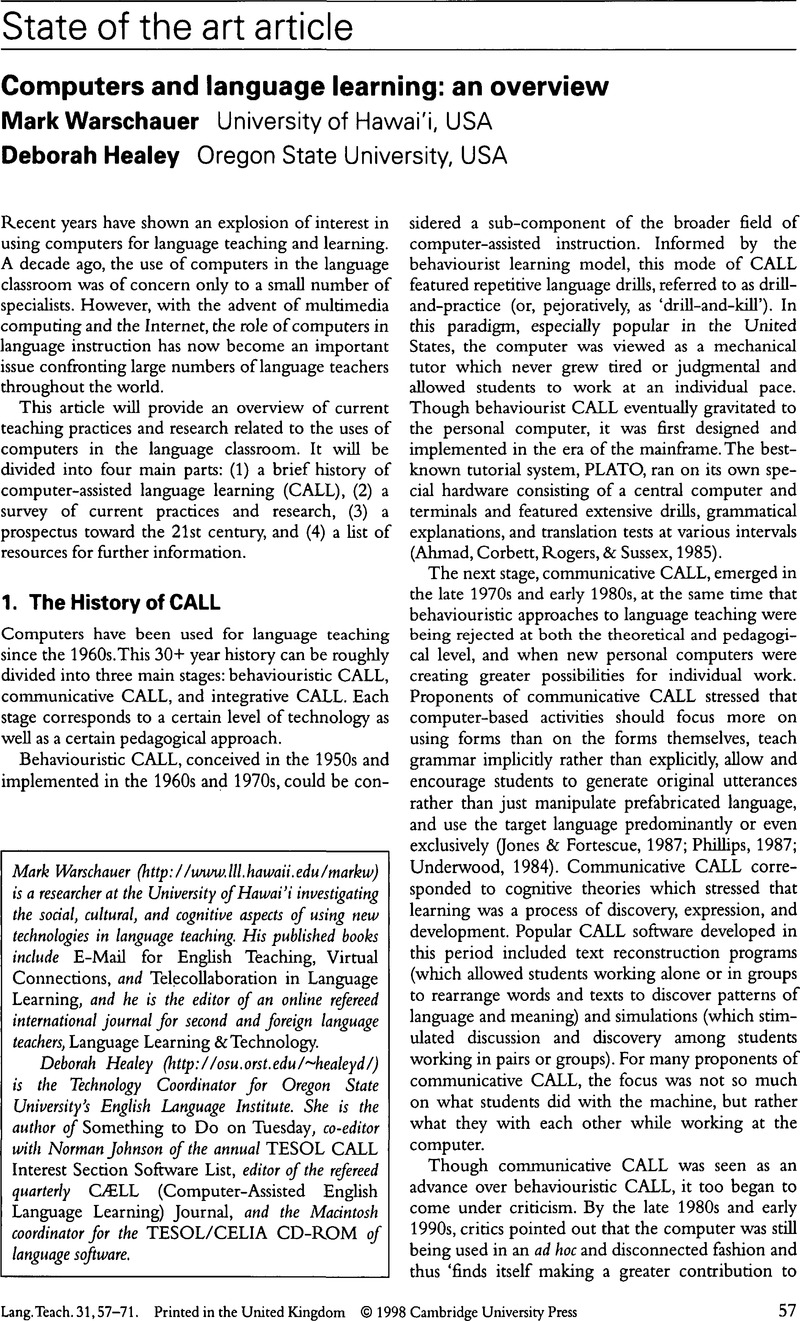Crossref Citations
This article has been cited by the following publications. This list is generated based on data provided by Crossref.
Barnes, Ann
and
Murray, Liam
1999.
Developing the Pedagogical Information and Communications Technology Competence of Modern Foreign Languages Teacher Trainees. Situation: all change andplus ça change.
Journal of Information Technology for Teacher Education,
Vol. 8,
Issue. 2,
p.
165.
Lam, Yvonne
2000.
Technophilia vs. Technophobia: A Preliminary Look at Why Second-Language Teachers Do or Do Not Use Technology in Their Classrooms.
The Canadian Modern Language Review,
Vol. 56,
Issue. 3,
p.
389.
Crystal, David
2001.
Language and the Internet.
Casanovas Català, Montserrat
2002.
Internet en la didáctica de las lenguas extranjeras: un paso adelante.
Íkala, Revista de Lenguaje y Cultura,
Vol. 7,
Issue. 1,
p.
53.
Bloch, Joel
2002.
Student/teacher interaction via email: the social context of Internet discourse.
Journal of Second Language Writing,
Vol. 11,
Issue. 2,
p.
117.
Lawrence, Geoff
2002.
The Use of E-mail as a Tool to Enhance Second Language Education Programs: An Example from a Core French Classroom.
The Canadian Modern Language Review,
Vol. 58,
Issue. 3,
p.
465.
Koulayan, Nicole
Detey, Sylvain
and
Sagaz, Michel
2003.
Les escamots d'aide sur cédéroms sont-ils bien perçus par les apprenants de langue étrangère ?.
Alsic,
Vol. Vol. 6, n°2,
Issue. ,
p.
101.
Bax, Stephen
2003.
CALL—past, present and future.
System,
Vol. 31,
Issue. 1,
p.
13.
Poon, Anita Y. K.
2003.
A Challenge for the Developer: Issues of interactivity and linguistic-cognitive appropriateness in English language learning.
Open Learning: The Journal of Open, Distance and e-Learning,
Vol. 18,
Issue. 2,
p.
135.
Casanovas, Montserrat
2003.
El correo electrónico como medio de aprendizaje lingüístico.
Culture and Education: Cultura y Educación,
Vol. 15,
Issue. 3,
p.
253.
Sifakis, Nicos C.
2004.
Teaching EIL—Teaching International or Intercultural English? What Teachers Should Know.
System,
Vol. 32,
Issue. 2,
p.
237.
Jarvis, Huw
2004.
Investigating the classroom applications of computers on EFL courses at Higher Education Institutions in UK.
Journal of English for Academic Purposes,
Vol. 3,
Issue. 2,
p.
111.
Zaitseva, E.
Bell, F.
and
Whatley, J.
2004.
International educational collaboration:student reactions to peer evaluation at a distance.
p.
735.
Wissmann, Liane Dal Molin
2004.
As "pedras" no caminho do conhecimento em um curso on-line: um estudo de caso.
Revista Brasileira de Linguística Aplicada,
Vol. 4,
Issue. 1,
p.
195.
Martins, Cláudia B.M.J.
Steil, Andrea V.
and
Todesco, José L.
2004.
Factors influencing the adoption of the Internet as a teaching tool at foreign language schools.
Computers & Education,
Vol. 42,
Issue. 4,
p.
353.
Lin, Janet Mei-Chuen
Lee, Greg C.
and
Chen, Hsiu-Yen
2004.
Exploring potential uses of ICT in Chinese language arts instruction: eight teachers’ perspectives.
Computers & Education,
Vol. 42,
Issue. 2,
p.
133.
Beatty, Ken
and
Nunan, David
2004.
Computer-mediated collaborative learning.
System,
Vol. 32,
Issue. 2,
p.
165.
Read, Timothy
Bárcena, Elena
Barros, Beatriz
Varela, Raquel
and
Pancorbo, Jesús
2005.
User Modeling 2005.
Vol. 3538,
Issue. ,
p.
144.
Seferoğlu, Gölge
2005.
Improving students’ pronunciation through accent reduction software.
British Journal of Educational Technology,
Vol. 36,
Issue. 2,
p.
303.
Shang *, Hui‐fang
2005.
Email dialogue journaling: attitudes and impact on L2 reading performance.
Educational Studies,
Vol. 31,
Issue. 2,
p.
197.


